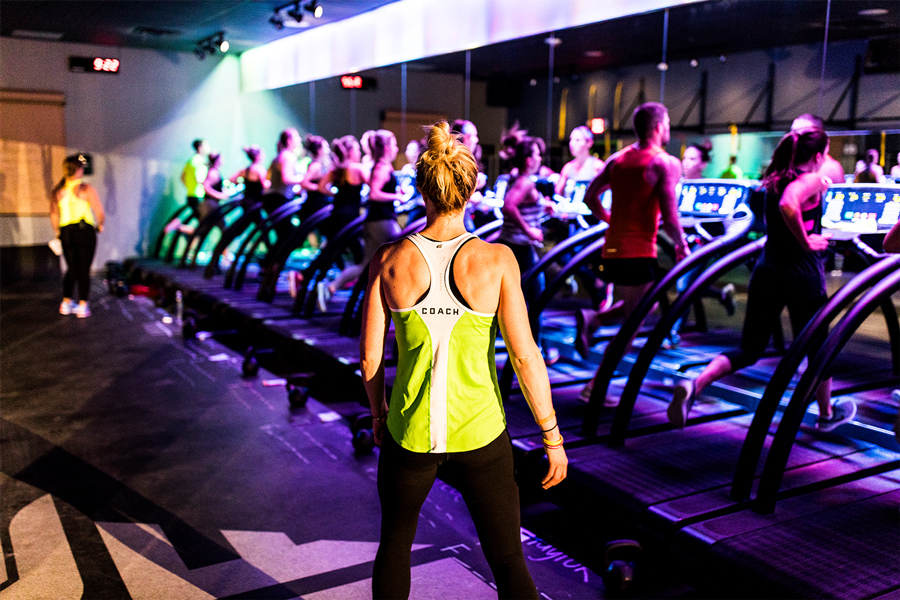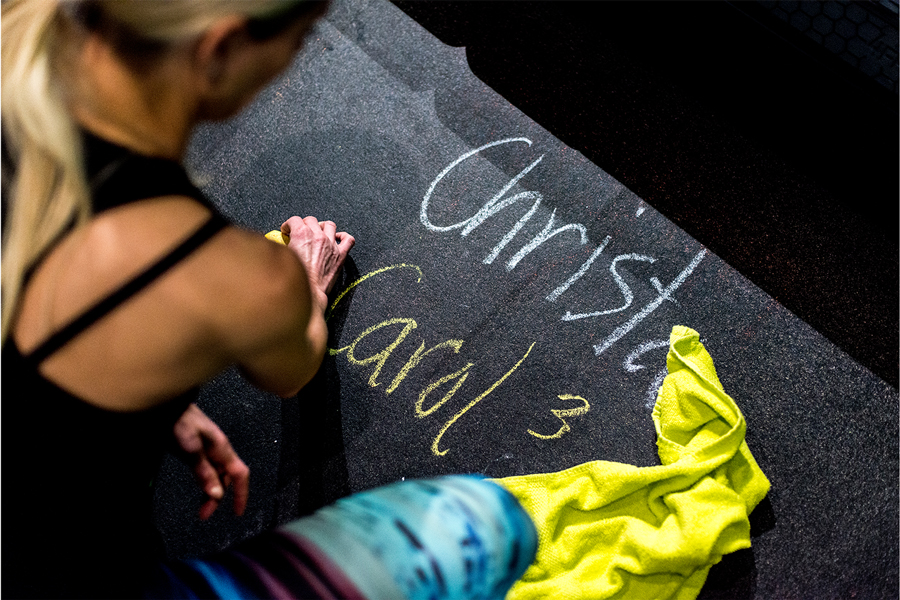
photos courtesy fly feet running
I can still remember walking into Fly Feet Running my first time to interview founder Kristin Shane in order to see what it was all about. Wires from what would become the lighting and sound system were hanging from the ceiling, the energetic green and yellow walls you see today were in their infancy as drywall, and Shane eagerly tried to get me to do push-ups with the rest of the coaches during their training going on in the background in what would be the gym (I did them, by the way). The workout studio wasn’t even completed yet, but you could sense the level of excitement the finished product would bring from the passion Shane brought to our interview. So I thought it would be fun to go back and interview Shane two years later, another studio in Wayzata later, and the foundation of a running program for a refugee camp in Uganda later to see what’s been happening at Fly Feet Running since the studio opened its doors. Spoiler alert: it’s thriving, and opening the eyes of its flyers to help them realize they can achieve more than they thought possible in the gym—and in life.
For those who aren’t yet familiar with a workout at Fly Feet or even Fly Feet itself, how would you describe it to them?
At the highest level, we exist to inspire people to chase the best version of themselves. And we do that through our workouts, which are all based in interval training. You do short efforts of running on the treadmill—at your pace—and then you do strength work on the floor—at your pace.
How has Fly Feet evolved since you first opened downtown?
We exist to inspire people to chase a better version of themselves. That’s the journey we’ve been on. When we opened, we couldn’t say that because people wouldn’t understand what we were. We had to be a little more basic in how we talked about ourselves. “We’re a workout studio. We do HIIT (high-intensity interval training).” But our purpose is really around this idea that we believe if we can get people to chase something better in there (the studio), it translates to their everyday lives. We had to earn the right with our flyers to be able to say that.

If it has, how has your barometer for success changed? When we last talked, you were on the verge of opening your downtown location, but now you’ve got a second location in Wayzata, a much larger crew, classes outside U.S. Bank Stadium, and more.
There are so many ways to measure success, but it really just comes down to the impact we have on people. When we launched, we set out to change the fitness paradigm. We do a lot of things different here. We wanted to create a brand that felt accessible to people, that felt inclusive, real and authentic. We went from one to two studios very quickly, and we feel really good about where we are, but we have our eye on the long game. Success is really about having a meaningful impact on people. If we can get the impact part right, I believe the results will follow.
How do you juggle it all?
Personally? Your question would suggest that I can, so thank you (laughs). Juggling suggests that you don’t drop a ball, and I drop many balls. I didn’t grow up with all these external forces that social media brings on. The false image that people can “juggle it all.” It’s just not true. I can’t imagine being earlier in my career and trying to find myself with social media. That is so difficult. I can’t juggle it all. No one really does. I just try my best. I make trade offs, and I try not to be too hard on myself, and prioritize the most important things.
What’s been one of the biggest lessons you’ve learned?
One of the biggest lessons for me starting Fly Feet was I underestimated how personally I would take everything. At Target, if we missed our sales for a month, or if a team member was unhappy, or I made a mistake, I was very accountable, and I had a sense of ownership to fix it, but multiply that by one hundred when it’s your own business. We’ve had members that have left us, and it’s like getting broken up with every time. I take it so personally. I want to know why, and what could we have done differently. I completely underestimated the level of personal investment and the mental capacity required. Coming into it, I felt a little immune, “I’ve run so many businesses, it’s going to be just like running businesses at Target.” Um, no.

Compared to the national brands such as Life Time and LA Fitness, Fly Feet seems much more personable, how do you and the team go about achieving this?
I think it all stems from what the business’ purpose is. And our purpose is to inspire people to chase the best version of themselves. We have to make sure we’re doing that in every single interaction, or else it’s not authentic, they’re just words. If you don’t have a purpose, then it is so easy for it to turn into just a transactional experience. I can’t express how easy it is for that to happen. I spend almost all my time focused on the people, and making sure my team is worried about the people. If I were worried about the numbers—which, by the way I am, you have to be—but if that’s all they saw me worrying about, then that just very easily sets the priorities. I still personally get every single email that anyone emails to Fly Feet, and every single transaction that happens at Fly Feet I get in my email. Is that scalable? No (laughs). But, I just want to make sure that if my team sees me focused on the people, then that’s the behavior that they model.
If you could pinpoint the most exciting part of this entire journey, or maybe a few, what would it or they be?
My team, hands down. We just had an offsite a few days ago where we shut Fly Feet down and brought the whole team together, and we talked about how we work together as a team, and how we make the flyer experience—we call it the 11 star experience—and how we continue to elevate the flyer experience. I’m most proud of the level of ownership that the team has over feeling accountable in helping people chase their goals.
I saw you went to Uganda back in June of this year to help build a running program for a refugee camp, did you ever see Fly Feet becoming that when this place was just drywall and wiring?
No, I did not see that coming. I sound like a broken record, but I think when you have a strong sense of purpose it helps you make decisions. It helps you know where you should play and where you shouldn’t play, and we’ve been fortunate where we’ve had a lot of partners ask us to do things with them, and we just say, “Will it inspire people to be better? Yes or no?” I was a Peace Corps volunteer when I was 25, so service has always been something that’s really important to me. When ARC asked us to work alongside them to put together a running program for refugee women, I jumped at the opportunity. We went to Africa in June and very quickly learned this idea that Maslow’s Hierarchy of Needs is very real. The words from one woman still stay with me: “I shouldn’t be running, I don’t have enough food to eat, I’m hungry all the time, but I would rather be hungry and hopeful than full and full of despair. Running helps me feel like there’s something better out there, and helps me go on with my life in this refugee camp. And if I didn’t do that, I’m not sure I could make it.” Goosebumps.

Are you still doing anything with them?
Yes. So we went down there in June so we could understand and get a lay of the land, and we’ve been building out the programming for them, and we’ll probably go back next year and roll out the program in Uganda. Hopefully we’ll take it to some other refugee camps in Africa, Rwanda is another one we’ll likely hit. It’s exciting.
Where would you like to see Fly Feet go in the future?
I think that when we set out to do this, I told you a little bit about what we wanted to do differently—a different brand, a different workout, a different coaching model, all with this idea of inspiring people to be better. And I think there’s a real opportunity for that. I think we still have opportunity in the Minneapolis-St. Paul market, so you’ll see more of us here (smiles). And then we’ll take Fly Feet to other markets.
What’s the best way or ways people can learn more about Fly Feet and its offerings?
Go to flyfeetrunning.com. The best way to come see us is on our intro offer. It’s three classes for $30. It gives you the opportunity to see how the workout changes dramatically every day. And doing three classes kind of helps you understand how it works for you. If you go to flyfeetrunning.com/firsttimer, it’ll give you some tips and tricks on what we’re about, and how to prepare and how to be ready for it.
Anything else you’d like to add?
Sure! Come fly with us! You don’t have to be a runner, or even like running. We’ll get you in the best shape of your life.
We do challenges four times a year. It’s the opportunity to snap it back, get back on the wagon, sort of hit the reset button and set yourself up for success. Am I drinking half my body weight in ounces a day? Am I getting eight hours of sleep at night? Am I training the way I want to train? Am I giving myself care the way I should? Our next one is in January, and it runs for 21 days. We always get a ton of people, and the community is great and super supportive. So if people are thinking about where they want to work out, do the three classes for $30 and see if it’s something that you like.






